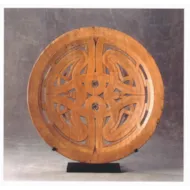A rare Surinam, Dutch Guiana, carved wood ceremonial tray
A rare Surinam, Dutch Guiana, carved wood ceremonial tray
Late 19th CENTURY
Size: 38cm diameter
Late 19th CENTURY
Size: 38cm diameter
Described as 'Bush Negro Art', the art of Africans in the Americas,
Surinam designs have their origins in 17th and 18th century West
African art forms. When the colony was handed over to the Dutch by the
English in 1667 many of the West African plantation slaves escaped into
the forest. These people were later joined by the descendants of the
slaves who gained emancipation in 1863. They intermarried with the
indigenous Indians to come extent, the remain the foremost group of New
World Negroes who have preserved in its purest form their racial
identity with their African ancestors. There are three principle tribes: the Saramaccaner, the Aucaner and the
Boni, all of whom live along the banks of the principle rivers that run
through the jungle of the interior of Surinam. This tray comes from the
Boni tribe and its design is significant in the context of fertility. Bush Negro art has evolved into an art form which is unique in style
and possesses a vitality of its own. With cultural contributions from
South American Indians, Africans and probably Europeans it is a
'primitive art' that still remains virtually untouched by the modern
rapid diffusion of Western artistic traditions.
Surinam designs have their origins in 17th and 18th century West
African art forms. When the colony was handed over to the Dutch by the
English in 1667 many of the West African plantation slaves escaped into
the forest. These people were later joined by the descendants of the
slaves who gained emancipation in 1863. They intermarried with the
indigenous Indians to come extent, the remain the foremost group of New
World Negroes who have preserved in its purest form their racial
identity with their African ancestors. There are three principle tribes: the Saramaccaner, the Aucaner and the
Boni, all of whom live along the banks of the principle rivers that run
through the jungle of the interior of Surinam. This tray comes from the
Boni tribe and its design is significant in the context of fertility. Bush Negro art has evolved into an art form which is unique in style
and possesses a vitality of its own. With cultural contributions from
South American Indians, Africans and probably Europeans it is a
'primitive art' that still remains virtually untouched by the modern
rapid diffusion of Western artistic traditions.
A rare Surinam, Dutch Guiana, carved wood ceremonial tray

SOLD



